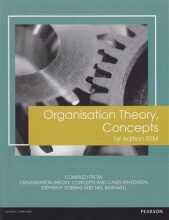Summary: Strategy & International Business
- This + 400k other summaries
- A unique study and practice tool
- Never study anything twice again
- Get the grades you hope for
- 100% sure, 100% understanding
Read the summary and the most important questions on Strategy & International Business
-
Lecture 1
This is a preview. There are 10 more flashcards available for chapter 03/12/2017
Show more cards here -
What are the three pilars of the strategic tripod?
Resource-based view (Barney, 1991)
Looks at the resources a company possesses, to determine whether the company has a sustained competitive advantage (Barney, 1991).
Industry-based view (Porter, 1980)
Porter’s five forces analysis and generic strategies focus on profits and competition within a specific industry.
Institutional-based view (Peng, Sun, Pinkham and Chen, 2009)
The humanly devised constraints that shape political, economical and social interactions. They make up the rules of the game within a society. -
What are the assumptions and limitations of the resource-based view (Barney, 1991)
The greatest limitation of the resource-based view is the lack of attention to context. Resources are sticky and cannot be redeployed by picking them up from one place and placing them somewhere else. For example, culture is sticky and cannot be transferred easily. Additionally, the resource-based view is a snapshot of a specific timeframe and therefore is not forward-looking. -
Explain the industry-based view (Porter, 1980)
Porter’s five forces analysis and generic strategies focus on profits and competition within a specific industry. Porter’s five forces analysis looks at the competitive forces within an industry: competitive rivalry, buyers, substitutes, suppliers and barriers to entry/exit. When the competitive forces are high, profits tend to be low and, therefore, the industry is unattractive. -
What are the assumptions and limitations of the industry-based view (Porter, 1980)?
Limitations- Firm-level contexts are aggregated (i.e. ignored)
- Depending on how you define the industry, the industry may be different in two different countries
- Static snapshot of an industry (challenge for dynamic industries)
Assumptions- Institutions function normally and an absence of voids (i.e. markets are efficient).
- Industries can be clearly defined and their barriers are clearly identifiable.
- Firm-level contexts are aggregated (i.e. ignored)
-
Lecture 2+3
This is a preview. There are 5 more flashcards available for chapter 04/12/2017
Show more cards here -
What are international new ventures?
International new ventures are businesses that, from inception, seek to derive significant competitive advantage from the use of resources and the sale of outputs in multiple countries. Their origin is international and they have a commitment (resources) to many countries (Oviatt & McDougall, 1994). -
Why does the traditional stage theory not apply to international new ventures?
The stage theory (i.e. gradual, risk-aware expansions does not apply to international new ventures for the following reasons (Oviatt & McDougall, 1994).- International new ventures have constrained resources (as opposed to large scale);
- They operate in volatile markets (as opposed to stable and homogeneous markets);
- They have little or no experience in markets (opposed to previous experience gained in similar markets)
- International new ventures have constrained resources (as opposed to large scale);
-
What are the advantages derived from going global from the beginning?
Isenberg (2008) argues that numerous opportunities exist for companies going global from the beginning.- Allows firms to tap resources or serve countries across countries;
- Allows firms to take on larger rivals;
- Chase global opportunities;
- Use distance to create new products or services;
- Political and economic barriers have fallen, allowing the world’s best manufacturing locations and vast quantities of information to be utilised;
- Additionally, the best talent can be recruited from across the world, investors from different regions can be attracted, and managers can learn how to manage international businesses from the beginning.
- Allows firms to tap resources or serve countries across countries;
-
Lecture 4
This is a preview. There are 4 more flashcards available for chapter 05/12/2017
Show more cards here -
Why is globalization much harder than portrayed in limited cases?
From Stadler et al. (2015) we can identify multiple reasons why globalization is much harder than portrayed because globalization is associated with large amounts of uncertainty.Under-anticipated (hubris - overestimate my abilities to overcome obstacles, i.e. less-than-expected effective marketing) and unanticipated (blind spots - things that we don’t know are going to happen) are major hindrances. The time-to-performance ratios are much longer than firms realize and therefore, strains the willingness to “wait”. -
Lecture 5
This is a preview. There are 20 more flashcards available for chapter 06/12/2017
Show more cards here -
What are the top five challenges of operating in China as viewed by US firms?
Institutional conditions are much more important in emerging economies than developed economies (often taken for granted here and only realise their impact when entering emerging economy).
- Inconsistent regulatory interpretation and unclear laws
- Institution
- Economic
- Institution
- Labour costs
- Institution
- Institution
- Obtaining required licenses
- Institution?
- Institution?
- Shortage of qualified employees
- Economic
- Economic
- Industry overcapacity
- Inconsistent regulatory interpretation and unclear laws
-
Why do some countries prosper and others fail?
- Primary reason is quality/strength of institutions
- Nogales, Arizona and Nogales, Mexico - same geography and climate, but institutions are very different and Arizona side has annual income three times higher than Mexican side of town
- Nogales, Arizona and Nogales, Mexico - same geography and climate, but institutions are very different and Arizona side has annual income three times higher than Mexican side of town
- Other reasons as well of course:
- Nordic countries tend to fare better than countries near the equator
- Countries with shoreline fare better than landlocked countries
- Surrounded by prosperous countries with large markets and high buying power
- Nordic countries tend to fare better than countries near the equator
- Primary reason is quality/strength of institutions
- Higher grades + faster learning
- Never study anything twice
- 100% sure, 100% understanding
































